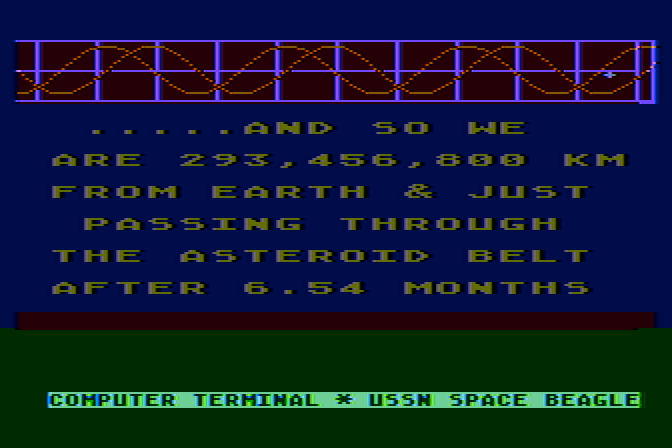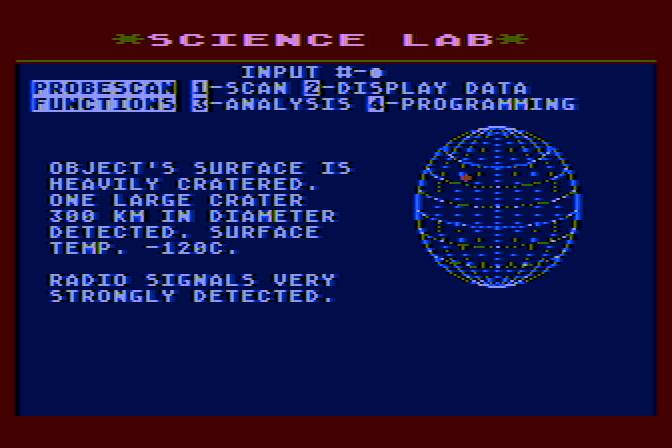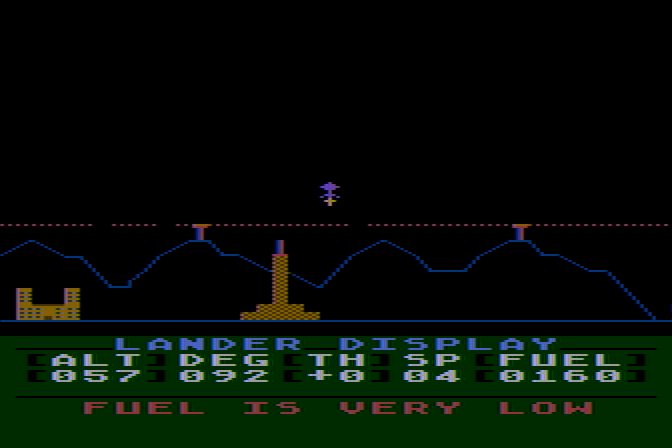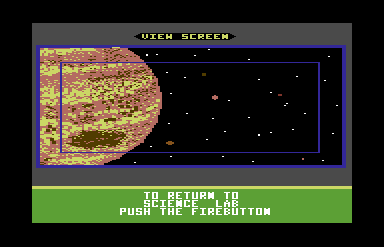Avalon Hill's Jupiter Mission 1999
Game Review
Game: Jupiter Mission 1999
Rating: C-
Long before home computers were a thing, Avalon Hill began publishing board games out of their headquarters in Baltimore, Maryland. Their main successes were in strategy and wargames with many common wargame designs (such as the hexagonal grid) having been of their creation. In 1980, Avalon Hill finally made the leap to computer games with their Micorocomputer Games division. Naturally, most of their games continued their strategy and wargame concepts that had worked so well as board games; many were even computer adaptations of some of these same games. There were original titles too, and they did release a few games outside of their usual wargame and historical simulations genres. I'd like to take a look at one of these titles this time around: Jupiter Mission 1999 for the Atari 400/800 (there is also a Commodore 64 version which is more or less the same outside differences due to hardware).
Many of the games in Avalon Hill's catalog are wargames, strategy, and historical simulations which were never really the type of games I particularly cared for, so I'll likely never review these as anything I might put together would probably be unfairly negative for even the best of them. In general, my impression is the quality is fairly middle of the road; not very impressive, but their niche audience probably enjoys them. Jupiter Mission 1999, however, is one of a handfull of their titles that seemed far more up my alley; a (more or less) realistic science-fiction action/simulation game. The premise of the game is you are one of a three-person crew aboard the USSN Space Beagle, a ship whose mission is to travel to Jupiter to investigate some strange radio signals that were detected. The game begins six months into the mission when an asteroid storm kills the other two crew members leaving you to complete the mission with the help of the onboard computer called Beagle. The game consists of 11 different mini-games which chart the progress from surviving the asteroid storm, repairing the ship, arriving at the correct location around Jupiter, and finally exploring a secret alien complex. Doesn't sound bad, and there's large range of gameplay styles mixed in including action and strategy sequences. The results of all this, though, aren't spectacular.
The documentation for Jupiter Mission 1999 is rather sparse; after the program is loaded, you can optionally jump right into the game or load a saved game, but if it's your first time playing you'll want to also view the introduction which provides the full backstory. While the manual does explain the game overall, it could be a little more helpful with details for some of the individual mini-games and tasks you'll encounter. Also included in the package you'll find a series of envelopes with "sealed orders" (aka hints) — the manual suggests you shouldn't open these unless you are really stuck, however I found that they aren't really hints in a traditional sense that they provide a cheat or might give away some secret you don't want to know yet, rather hey are actually more like additional instructions which read like they really should have just been a part of the manual. I guess the developers intended figuring out how to play was part of the game's challenge? Either way, there's no earth shattering secrets or surprises revealed if you do open the envelopes, so I wouldn't worry about accidentally ruining the game experience if you take a peek.
Whether you end up reading the intro or not, the game begins right away with an action sequence, the asteroid storm. This section features a first-person view where players need to destroy any incoming asteroids to avoid them damaging the ship. Asteroids appear one at a time, and you only get one shot for each asteroid. There are, however, a few annoyances which guarantee you'll sustain at least some damage no matter how good you are. The first issue is the cursor speed; some asteroids move fast, and it's very possible you won't be able to target the asteroid in time no matter how quick your reflexes. The even more annoying possibility is an asteroid sneaking by in the bottom right or bottom left corners. The cursor can't move over the entire screen, so some asteroids pass by entirely outside the range where you can fire making it impossible to avoid sustaining damage. The graphics and sound in this section are decent, but those cheap shots can make it more frustrating than fun at times. I guess that's one way to ensure you aren't too good and have at least something to do in the second part.
Given that your ship will most definitely will sustain some damage, the next part of the game is to repair it. This part is probably the worst section of the entire game. An illustration shows the entire ship where you can move the selection to each segment of the ship. The computer analyzes and reports if there's any damage in the segment. Each segment that does have damage needs to be repaired; you will also find three segments that can't be repaired as per the introduction these are what caused your situation in the first place. The repair sequence is a bit confusing at first and involves trying to time key presses when correct colors are flashing; the sound decreases in pitch as repairs are made, or if there are too many mistakes sounds increase in pitch until eventually there is permanent damage. The instructions for this process aren't particularly clear, but once you get the gist of what needs to be done it's not too difficult. Repairing the full ship, however, ends up being extremely repetitive and boring. There are likely enough damaged segments that you'll need to repeat the exact same exercise numerous times, and once you figure out the process having to repeat it another 10 to 20 or however many times is uninteresting. The sounds in this section are irritating after a while as well. This section overall should have had a better design; conceptually for the game's progression having to make repairs makes sense, but the mechanism used makes little sense, is all around terrible, and is definitely an area that could have been better thought out.
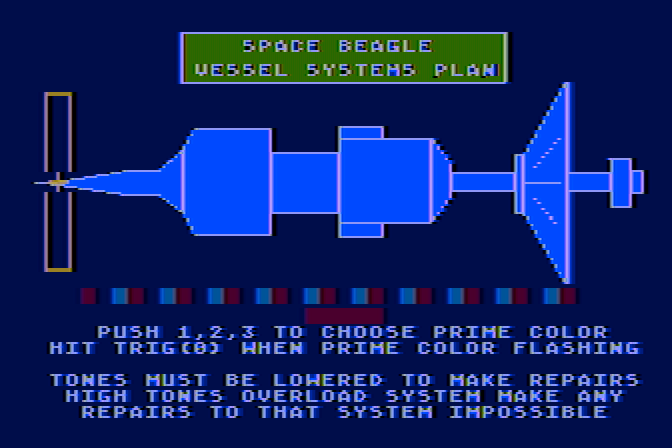
After a rough start, things do get somewhat better, mostly. Now that we've got our ship back, it's time to get back on course and head to Jupiter. This process is more less a guessing game, using the provided scanners and map players need to determine the correct angle to adjust the trajectory to. The Space Beagle has very little fuel, just barely enough to complete the mission in fact, so there isn't much room for error. Getting the correct course can be tough; being off by just a degree causes you to miss Jupiter, and you'll need the excess fuel later in the game so there isn't much course correction possible. Similarly, once your course is set you'll also need to send out some probes and explore the Jupiter system to locate where the radio signals are coming from. This process involves repeatedly changing the probes programming instructions, sending the instructions, activating the program, waiting for a response, and repeating until you've found the source of the signals. Actually, I'm guessing this process probably isn't that far off from what would really need to be done to control space probes, but for a game it can be a slow, repetitive endeavor. There's not much of a strategy or puzzle to solve here, it's just a matter of checking out each of the moons one by one and noting where the radio signals are. Another irritation in this sequence is the menu structure. Even after figuring out how to perform all of the necessary actions, navigating through the menu isn't straight forward with some menu items containing similar names that make it easy to get lost. For example, there are two menu items called probescan, one in the probe programming menu and one in the transmit menu with the intent of one for creating a probescan program and the second for actually sending your program to the probe. Although in different menus performing different actions, it can still be easy to become disoriented as to where you are in the menu structure. Part of the reason for this is the 40-column font being used along with some space dedicated to graphics so there isn't much room for more verbose text; You'll get used to it, but it's another area where some refinement could have improved the experience. As you navigate the menus, there are some delays which make the whole sequence slow; as you switch between some of the screens you'll again be waiting for data to load, and even when there isn't disk access the menu isn't super responsive with pauses between different menu items appearing. Overall a semi-decent simulation of space exploration, but it's too tedious and luck will play a role into how much time you have to spend searching the moons for a signal.
More action sequences are up next! Once you know where you need to go, you'll need to land there. This scenario should be familiar to anyone who has played any type of Lunar Lander game; gravity is pulling your ship down, and you need to use your limited fuel to make it to the landing location and ensure the rate of descent is within safe limits. Hitting any obstacles or landing too fast is deadly! Overall this sequence is decent, but the controls are a little twitchy making it difficult to course correct if you're only off the target by a little bit. There's also an annoying quirk (or bug even) caused by the screen scrolling; if you are descending and move either left or right enough to cause the screen to scroll again, you could end up crashing unexpectedly. This is because the ship's location ends up lurching left or right to follow the screen and doesn't fully keep it's relative in-game location; if a mountain or other obstacle is in the path, your ship is moved right into it and destroyed! The segment is difficult enough, but this scrolling quirk can really add to the annoying factor. Too bad, as fixing that wouldn't diminish the challenge but would sure make it more fun!
Once landed, a probe is sent into an alien complex to explore which becomes our next game sequence. This area is essentially a maze game; players need to guide the probe through the complex which consists of numerous corridors, locked doors, rubble blocking paths, and more. Some of the computers encountered can be analyzed to open doors and paths, but many are just useless so some searching is needed. Eventually key cards are found to unlock some of the doors, and even a ray gun to clear rubble can be picked up. This part isn't bad, but I wish the scrolling was smoother. The probe moves along fine when the screen doesn't scroll, but becomes slow and jerky when it does. In typical fashion for this game, the length of the sequence is really drawn out by having a maze that is quite large and due to locked doors and lifts you'll need to go back and forth a lot to locate the necessary keys to unlock doors. Once the maze is solved, however, you'll need to do it again: this time in reverse with the lights out! Oh geez. At least the sensor messages give you a few clues...but if you haven't mapped out how you got to the end location, reversing course in the dark can be difficult!
And then, the game continues on for another, final action sequence; after taking off from the alien complex, you can then land at an alien base. This one is protected by guns, and your goal is to guide a robot through the gauntlet to reach the self-destruct mechanism at the end. Pretty straightforward, but it becomes repetive quickly; there's no real variation to the path at all and it becomes tiresome quickly. The bottom of the screen has an indicator showing how far you still have to go, but otherwise the entire sequence looks the same with the same pattern of guns firing simultaneously over and over again just repeating. Luckily, you're given nine robots and if one is hit you aren't sent entirely back to the beginning, but it's still tough and having each section from start to finish being an identical repeat makes this part of the game worse than it should have been. Should you make it past all of this, however, you'll finally encounter some of our aliens who try to stop you from pushing the self-destruct button! If you have the patience to make it through all of these mini-games you'll have then won the game and the story concludes. And, as the ending informs, there is a sequel! Your adventure continues in Quest of the Space Beagle.
One of the major limitations of many Avalon Hill games is that they are written in BASIC with the goal of making ports to numerous platforms relatively quick and easy. Aside from performance limitations, this also unfortunately means the version of games for more advanced computers often don't take much if any advantage of graphics or sound capabilities. This includes the IBM PC, Atari 400/800, and others where some games look and play very similar to the version for older computers such as the TRS-80 and Commodore PET. Fortunately this is less of an issue for Jupiter Mission 1999. Even though it is also written in BASIC, this game is limited to just two platforms, both of which have impressive graphics and sound capabilities for their era. As Atari BASIC allows access to most of the system's advanced features, Jupiter Mission actually ends up looking and sounding pretty good for the most part, certainly better than is common for a BASIC program of the time. As noted a few times already, a recurring problem with this game is the loading times; the game frequently chains from one BASIC program to another causing delays while the next program or some data is retrieved from disk. On the plus side, although the game is spread across four disks, swapping between them is infrequent. The mission proceeds in a linear fashion from one mini-game to the next, so generally once you're able to proceed to the next disk you won't need to switch to a different disk for a while. Although the linear progression through the game does reduce disk swapping, it also really highlights the fact that you're just being guided from one BASIC program to the next in a predetermined sequence that more or less follows the story. There's not a lot of connection between the programs to tie them all together, and your performance in one section sometimes doesn't have any effect on the later sections. The sequence does make sense given the game's premise, but with each sequence being pretty isolated the overall effect is that the game appears more like a compilation of individual sci-fi programs than a single game. It is possible to save progress between sections and sometimes during, and I recommend doing so often! It would be beyond annoying to have to begin the adventure from the start every time you died, so this is a welcome feature you will want to take advantage of.
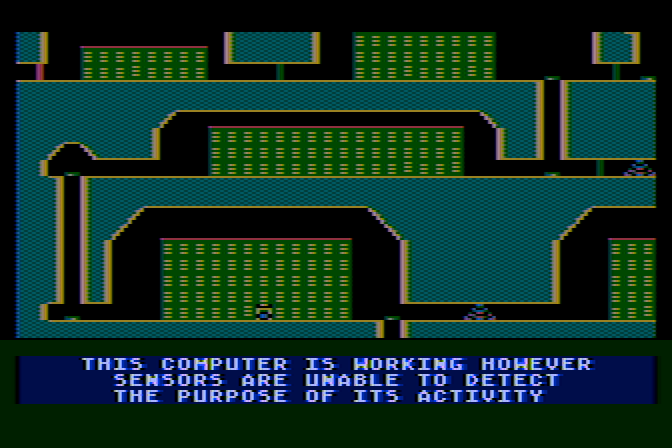
One thing Avalon Hill has always excelled at was their artwork. With a team on hand to create box covers, illustrations, game boards, and whatever else was required for their board games, it seems they were able to tap into the same talent for the computer game packaging. As most of their games even came in unusually large boxes similar to those of their board games, I'm guessing distribution and display on a shelf along with their board game counterparts was part of the marketing strategy. Jupiter Mission 1999 is no different, and I have to give a lot of credit to artist Jim Talbot for putting together an outstanding illustration for this one!
Overall, I wanted to like Space Mission 1999 a lot more than I did; conceptually, the idea of a serious science-fiction RPG/adventure is a good one, and it has some great elements to form a mission that is reasonably coherent and combines a few true to life challenges that could be faced on a real journey to Jupiter. Even as a BASIC program, the game makes great use of Atari's sprites and display list interrupts to mix different graphics and text for a solid visual presentation. Sound makes use of Atari's POKEY chip quite well and is a nice addition (at least outside of that annoying repair sequence). Unfortunately, the frequent loading during some sequences is an irritation, and many of the games are frustrating and some are even just plain old boring. Many of the sequences feel drawn out just to extend the length of the game; in that final alien space station do we really need to sneak past the same exact guns 16 times, for example? So while the game has an excellent premise and a lot of variety, it just isn't that great as a whole. Some issues are hard to get around with the technology of the time; disk access was always slow, but had the game gone with programming in something other than BASIC it could potentially have been more efficient and needed to access the disk less often. BASIC or not, some additional gameplay tweaks and redesigns would have gone a long way to making the game better (such as some minor changes to the action sequence controls, escpecially in the Lunar Lander sequence, or improving the repair sequence). Some of these quirks may have been more tolerable at the time, but certainly haven't helped the game age well. It is nice that Avalon Hill tried to round out their catalog with some different themes and gameplay styles, but I'm still going to rate this one as a C-; it's a neat one to check out, but there's better games from the era you'll want to move on to.
Commodore 64 Version Differences
Overall the Commodore 64 is quite similar to the Atari version; it's still written in BASIC, but there are now two fewer disks! The gameplay is also more or less the same with all of the same issues, but there are a few places with mild differences; in the initial asteroids action sequence, you don't have those shots that are impossible due to the asteroid remaining outside the targeting area so that's a plus. It's still difficult though, and you will definitely sustain damage. One thing to lookout for is you have to wait for the asteroid to be large enough in the view; it seems the asteroids have a psuedo 3D effect and get larger as they get closer, but your shots don't — they don't "fire into the distance" as you might expect after playing games like Star Raiders. This creates a frustrating situation where it appears visually you hit an asteroid dead-on but it registers as a miss. During the landing sequence, the scrolling seems smoother than in the Atari version and I didn't encounter that scroll/crash glitch which is nice, however if you pass your target too much you are stuck unless you have enough fuel to make another orbit so the screen wraps around again! Graphically, the Commodore version is overall slightly more colorful and doesn't rely on artifact colors as some Atari screens do. Given the C64's capabilities, some of the fonts are unnecessarily blocky though. The sound is, of course, slightly different due to the different sound chip and also works well enough for most of the game (the repair sequence is still annoying).
